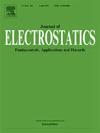太阳能电池板的电动除尘技术综述
IF 1.9
4区 工程技术
Q3 ENGINEERING, ELECTRICAL & ELECTRONIC
引用次数: 0
摘要
本文综述了用于减少光电元件(如光伏板)上灰尘粘附和积聚的电动防尘罩(EDS)系统。EDS系统通过向平行电极施加两相或多相高压而产生的电动力驻波或行波来传输带电粒子。在简要介绍了EDS系统的研究和发展历史之后,介绍了理论和数值研究。他们阐明了电动力场中粒子动力学的机制,并预测了月球和火星上低重力和低压环境下的清洁性能。随后,本文介绍了系统配置,包括清洁板和电源,以及基本特性,包括电极配置,施加电压和频率以及环境条件的影响。它还描述了EDS系统的两种主要应用的现状:清洁在太阳能发电厂使用的大型PV板上沉积的灰尘和清洁光学元件,如PV板、热辐射器、透镜和安装在月球和火星探测漫游者上的镜子。此外,讨论了未来面临的挑战,并介绍了其他空间应用,如宇航服的清洁、月球风化层的运输和粒径分类,以及月球和小行星上的风化层和水冰颗粒的采样。本文章由计算机程序翻译,如有差异,请以英文原文为准。
Electrodynamic dust removal technologies for solar panels: A comprehensive review
This paper reviews electrodynamic dust shield (EDS) systems used to mitigate dust adhesion and accumulation on optical elements, such as photovoltaic (PV) panels. The EDS system uses an electrodynamic standing wave or travelling wave, generated by applying a two-phase or multi-phase high voltage to parallel line electrodes, to transport charged particles. After presenting a brief history of the research and development of EDS systems, theoretical and numerical investigations are introduced. They elucidate the mechanism of particle dynamics in the electrodynamic field and predict cleaning performance in low-gravity and low-pressure environments on the Moon and Mars. Subsequently, the paper presents the system configuration, including a cleaner plate and power supply, and fundamental characteristics, including the effects of electrode configuration, applied voltage and frequency, and environmental conditions. It also describes the current status of two primary applications of EDS systems: the cleaning of dust deposited on large-scale PV panels used in solar power generation plants and the cleaning of optical elements, such as PV panels, thermal radiators, lenses, and mirrors mounted on rovers for lunar and Martian exploration. In addition, future challenges are discussed, and other space applications are introduced, such as cleaning of spacesuits, transport and particle-size classification of lunar regolith for the in-situ resource utilization, and sampling of regolith and water ice particles on the Moon and asteroids.
求助全文
通过发布文献求助,成功后即可免费获取论文全文。
去求助
来源期刊

Journal of Electrostatics
工程技术-工程:电子与电气
CiteScore
4.00
自引率
11.10%
发文量
81
审稿时长
49 days
期刊介绍:
The Journal of Electrostatics is the leading forum for publishing research findings that advance knowledge in the field of electrostatics. We invite submissions in the following areas:
Electrostatic charge separation processes.
Electrostatic manipulation of particles, droplets, and biological cells.
Electrostatically driven or controlled fluid flow.
Electrostatics in the gas phase.
 求助内容:
求助内容: 应助结果提醒方式:
应助结果提醒方式:


